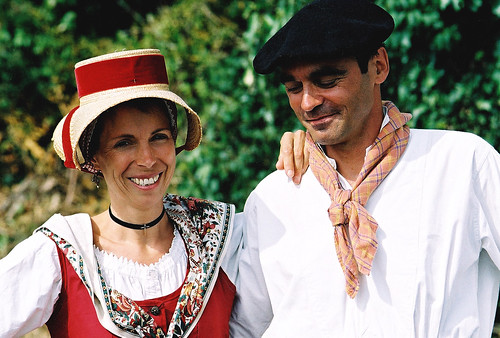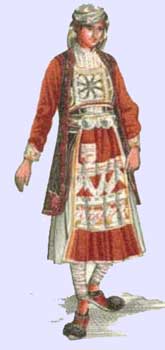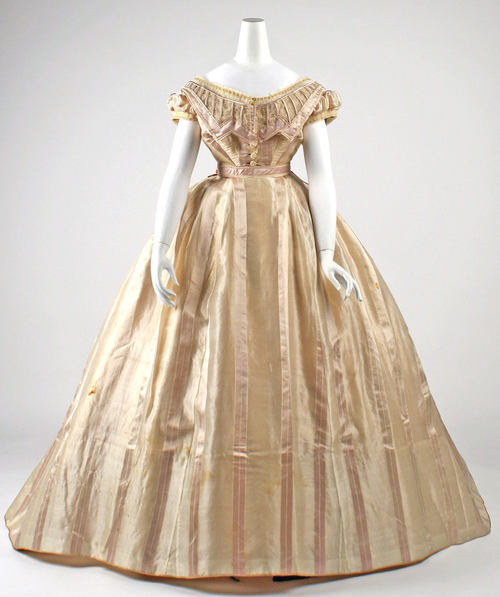source(google.com.pk)
French Traditional Dress Biography
Identification. French national identity is based on the historical origins of the nation in Celtic, Gallo-Roman, and Frankish cultures. The name "France" originally was used to refer to several peoples in the lower Rhineland. It gradually was introduced as a more widespread term to denote that territory, formerly known as Gaul, after the Frankish invasion and the retreat of the Romans. The name "Francia" was applied to various territorial units until the Middle Ages, when it came to signify the kingdom of the French sovereign. Regional identities, such as Provencal and Breton have coexisted with political units of state control. The degree to which France is today a homogeneous nation is a highly contested topic. Political and linguistic unification, especially through mass education, has been an ongoing project of nationalism. The immigrant population comes mainly from Portugal and northern Africa, although there has been increasing immigration from eastern Europe. France takes a highly assimilationist approach to its immigrant populations. The social position of Beurs (the children of North African immigrants) is an ongoing issue. The population is divided by social class, political party affiliation, generation, ethnicity, and region. Having had a significant rural population well into the twentieth century, the country continues to be marked by a rural-urban split.
French clothing is not only inherently chic, but it is also legendary in its design and rich history. From exquisitely crafted haute couture to Coco Chanel's little black dress, French clothing has been admired and loved by fashion connoisseurs since the reign of Louis XIV. As many fashion houses dissolve because of lack of public interest or economic woes, many French clothing companies have thrived even after the deaths of their legendary creators.
According to FashionEncyclopedia.com, the reign of French king Louis XIV created a shift in the creation of French apparel and luxury goods. In the mid-1600s to early 1700s, he ceased the import of fabrics and goods into France and created a powerful industry producing silk, ribbons and other fine textiles. As a result, France became a major exporter of textiles and luxury clothing to all of Europe.
Notable years in French clothing history include 1910, when Coco Chanel opened her first shop on Rue Cambon, and 1947, when Christian Dior created the "New Look."
Significance
Paris, Milan, Tokyo and London are considered premier cities for fashion innovation and design. Many famous French design houses, including Balmain, Lanvin, Chanel, Louis Vuitton, Christian Dior, Yves Saint Laurent, Mainbocher and Guy Laroche, created iconic clothing designs that are sold in vintage boutiques and upscale department stores worldwide. French tennis star Rene Lacoste created garments with an embroidered alligator, which was the first instance of a designer logo used in fashion.
In the 21st century, French clothing is prominently featured in magazines and designer fashion shows. In the mid-1600s, the French fashion press was created by Jean Donneau de Visé to advertise the styles of clothing worn by members of the royal court. Elle magazine, a legendary fashion bible for style arbiters, was founded in 1945. Paris holds two important fashion weeks in February and September to display clothing for fall/winter and spring/summer collections.
Types
There are three major types of French clothing sold worldwide: prêt-à-porter ("ready to wear"), French lingerie and haute couture. Yves Saint Laurent revolutionized the fashion industry in 1966 by designing clothing ready for mass distribution. Haute couture is a legal term that refers to hand-sewn designer clothing made by couturiers. With designs that range from $10,000 to $200,000 or more, fewer than 200 women worldwide wear couture. A couture garment can take months to make. Only garments made by clothiers designated by the Fédération française de la couture are considered couturiers.
Expert Insight
In comparison with their American fashion-obsessed counterparts, the French have a very different approach to their clothing purchases. Rarely do the French buy items on sale. In addition, the French consider their clothing, jewelry and handbags to be investment pieces to pass on to the next generation. Rather than stuff their closets with half-priced items that are cheaply made, the French purchase a few pieces of clothing that are more expensive but will last for decades instead of one season only.




 French Traditional Dress
French Traditional Dress
 French Traditional Dress
French Traditional Dress
 French Traditional Dress
French Traditional Dress
 French Traditional Dress
French Traditional Dress
 French Traditional Dress
French Traditional Dress
 French Traditional Dress
French Traditional Dress
French Traditional Dress Biography
Identification. French national identity is based on the historical origins of the nation in Celtic, Gallo-Roman, and Frankish cultures. The name "France" originally was used to refer to several peoples in the lower Rhineland. It gradually was introduced as a more widespread term to denote that territory, formerly known as Gaul, after the Frankish invasion and the retreat of the Romans. The name "Francia" was applied to various territorial units until the Middle Ages, when it came to signify the kingdom of the French sovereign. Regional identities, such as Provencal and Breton have coexisted with political units of state control. The degree to which France is today a homogeneous nation is a highly contested topic. Political and linguistic unification, especially through mass education, has been an ongoing project of nationalism. The immigrant population comes mainly from Portugal and northern Africa, although there has been increasing immigration from eastern Europe. France takes a highly assimilationist approach to its immigrant populations. The social position of Beurs (the children of North African immigrants) is an ongoing issue. The population is divided by social class, political party affiliation, generation, ethnicity, and region. Having had a significant rural population well into the twentieth century, the country continues to be marked by a rural-urban split.
French clothing is not only inherently chic, but it is also legendary in its design and rich history. From exquisitely crafted haute couture to Coco Chanel's little black dress, French clothing has been admired and loved by fashion connoisseurs since the reign of Louis XIV. As many fashion houses dissolve because of lack of public interest or economic woes, many French clothing companies have thrived even after the deaths of their legendary creators.
According to FashionEncyclopedia.com, the reign of French king Louis XIV created a shift in the creation of French apparel and luxury goods. In the mid-1600s to early 1700s, he ceased the import of fabrics and goods into France and created a powerful industry producing silk, ribbons and other fine textiles. As a result, France became a major exporter of textiles and luxury clothing to all of Europe.
Notable years in French clothing history include 1910, when Coco Chanel opened her first shop on Rue Cambon, and 1947, when Christian Dior created the "New Look."
Significance
Paris, Milan, Tokyo and London are considered premier cities for fashion innovation and design. Many famous French design houses, including Balmain, Lanvin, Chanel, Louis Vuitton, Christian Dior, Yves Saint Laurent, Mainbocher and Guy Laroche, created iconic clothing designs that are sold in vintage boutiques and upscale department stores worldwide. French tennis star Rene Lacoste created garments with an embroidered alligator, which was the first instance of a designer logo used in fashion.
In the 21st century, French clothing is prominently featured in magazines and designer fashion shows. In the mid-1600s, the French fashion press was created by Jean Donneau de Visé to advertise the styles of clothing worn by members of the royal court. Elle magazine, a legendary fashion bible for style arbiters, was founded in 1945. Paris holds two important fashion weeks in February and September to display clothing for fall/winter and spring/summer collections.
Types
There are three major types of French clothing sold worldwide: prêt-à-porter ("ready to wear"), French lingerie and haute couture. Yves Saint Laurent revolutionized the fashion industry in 1966 by designing clothing ready for mass distribution. Haute couture is a legal term that refers to hand-sewn designer clothing made by couturiers. With designs that range from $10,000 to $200,000 or more, fewer than 200 women worldwide wear couture. A couture garment can take months to make. Only garments made by clothiers designated by the Fédération française de la couture are considered couturiers.
Expert Insight
In comparison with their American fashion-obsessed counterparts, the French have a very different approach to their clothing purchases. Rarely do the French buy items on sale. In addition, the French consider their clothing, jewelry and handbags to be investment pieces to pass on to the next generation. Rather than stuff their closets with half-priced items that are cheaply made, the French purchase a few pieces of clothing that are more expensive but will last for decades instead of one season only.
French Traditional Dress

French Traditional Dress
French Traditional Dress

French Traditional Dress

French Traditional Dress





No comments:
Post a Comment